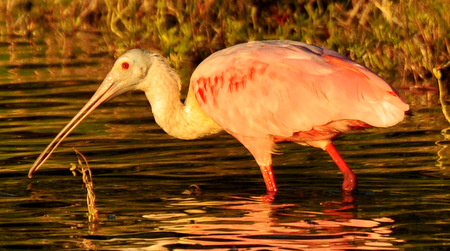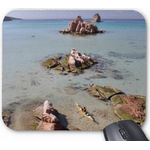Photo album:
• Everglades NP
Related links:
• Everglades National Park
• Backcountry permits
 Hell's Bay Canoe Trail
Hell's Bay Canoe Trail
This is a 2-day activity.
Facts:
Distance: 6.9 miles each day
Duration: 5:30 h. 1st day, 3:15 2nd
Date: 11/23/2012
Gear: Canoe
Introduction
This place has this name for a very good reason: Where the Hell Am I? Except for the 2 open bays, the rest of the water trail is a total maze of mangrove channels. Some of them are as shallow as your canoe, making it even difficult to paddle. Some of them are so brushy and narrow it makes you think you are making your own way through the mangroves. Fortunately, the entire trail is marked by white cylindrical poles. Prey there is none missing when you go. Start looking for the next marker as you pass the current one. Maps are totally useless. Watch your head for low branches. Be careful your paddle doesn’t get stuck with the vegetation and you lose it. Maneuver the sharp turns and back up when you canoe tip meets the friendly mangroves. Ah, if you have time, enjoy the absolute solitude of this fantastic place.
We had never used a canoe before, only single kayaks. At the rental store they call this situation the divorce canoe. It wasn’t that bad… after the second hour! They drop you off at the trail head, give you a few hints how to use the canoe and off you go. After the first turn, you are absolutely surrounded by mangroves, including above you. The water is also intimidating with its reddish algae covered bottom. There is not much to see in any direction, except if you are in a straight stretch but the combination of fear to get lost, solitude and the unknown of what’s lurking from inside the vegetation keeps you alert and excited. After we got a handle on the canoe, relaxed about coral snakes jumping in and giant aligators tipping it over, we actually began to enjoy the trip to Hell’s Bay.
The wild life was inexistent during the entire trail except for a water snake that swam across the channel. The couple we shared the chickee with had been there many times and said they have seen pods of dolphins fishing and a lonely gator close to the chickee several times. We had no luck.
This trail can be done out and back in a single day but it's better to spend the night at the chickee. On the second day, it can be combined with the Snake Bight water trail if you head out of the chickee early in the morning.
Description of the route:
From the trail head to the Hell’s Bay Chickee it’s 6.9 miles. The first half is a complete labyrinth of narrow channels with even some mangrove tunnels. The second half is more open, offering ample views of the bays you’ll cross. The poles marking the trail are, in general, visible when you get close to a fork. Some of them don’t become obvious until you are right at the turn. In some cases, you only find them when you think you’re lost.
At mile 3.7 is the Lard Can campground, the first spot you can get a permit to spend the night. It’s not obvious on the way out since it’s somewhat hidden on your right hand side. Less than a mile ahead, you enter the Pearl Bay, the first wide open bay. Far ahead you should be able to see the Pearl Bay chickee (mile 4.8), a good place to have lunch and go to the restroom. Resuming from here was the trickiest point for us. The Pearl Bay chickee is not place along the trail, you have to deviate to get to it. On top of that, the marker to follow towards the Hell’s Bay chickee is not visible from the Pearl Bay chickee. Paddle out of the Pearl Bay chickee on a S-SW direction and follow the coast on your right hand side for about 0.3 miles. You should find a channel opening at waypoint 115Marker. Follow the channel in a West direction to get to the Hell’s Bay. This bay seems small at the beginning. After 0.3 miles of paddling NW you enter the bigger section of the bay. At mile 5.8 you will see the last marker on the right hand coast. After that, head for the two islands in the middle of the bay in a SW direction. There is a reassuring pole in the middle of the bay. Keep that same direction and look for a channel when you hit the mangroves. The crossing of this section of the bay is about 0.6 miles. The wide channel turns right at the entrance and after a few zigzags (0.3 miles) you get to the next opening where you should be able to see the Hell’s Bay chickee on the West, about 0.2 miles away.
A chickee is a man-made roofed platform a few inches above the water and about 25 feet from land. The ones we saw had two platforms connected by a boardwalk with a pit toilet in the middle. In theory, the chickees are a better place to spend the night, compared to the land campgrounds, since they are away from the vegetation where the mosquitos are. When we went, there were very few mosquitos and we couldn't tell the difference between the chickee and the campground next to the visitor center. After setting up the tent (no pegs allowed), we explored the rest of the bay. The sunset is particularly beautiful if you paddle West past the chickee, since there are no mangroves obstructing the view.
On the way back the next day, we set out early in the morning expecting to see more wildlife but we only saw some flocks of ducks on the wide bays and a couple of vultures soaring high up. Compared with the amazing quantity and variety of other areas in the park, we were deceived by the lack of wild life here. Nonetheless, the experience is totally worth it.
For lots of birds, just walk around the Echo pond (close to the Flamingo Visitor Center) at sunrise or sunset. You will see lots of ibis, roseate spoonbills, pelicans, egrets, herons, king fishers and even a nesting couple of ospreys. The concentration of birds is amazing and at close range. The central island of the pond offers them a safety distance and they were not afraid of us at the shore. Another excellent area for aquatic birds is the Snake Bight canoe trail. Finally, you cannot miss road 94 in the neighboring Big Cypress Wilderness area. This dirt road teams with life at every single vegetation clearing. Not only the cypress forest growing in the swamps is a beautiful image but the alligators basking in the sun on the road side and the myriad of birds offer incredible photographic opportunities, especially in the morning when the sun illuminates the swamp. It just feels right to see herons fishing between the cypress knees while the gators float still or slither away without disturbing the glassy surface.


